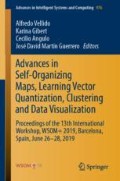Abstract
The advancement of available technology in use cause the production of huge amounts of data which need to be categorised within an acceptable time for end users and decision makers to be able to make use of the data contents. Present unsupervised algorithms are not capable to process huge amounts of generated data in a short time. This increases the challenges posed by storing, analyzing, recognizing patterns, reducing the dimensionality and processing Data. Self-Organizing Map (SOM) is a specialized clustering technique that has been used in a wide range of applications to solve different problems. Unfortunately, it suffers from slow convergence and high steady-state error. The work presented in this paper is based on the recently proposed modified SOM technique introducing a Robust Adaptive learning approach to the SOM (RA-SOM). RA-SOM helps to overcome many of the current drawbacks of the conventional SOM and is able to efficiently outperform the SOM in obtaining the winner neuron in a lower learning process time. To verify the improved performance of the RA-SOM, it was compared against the performance of other versions of the SOM algorithm, namely GF-SOM, PLSOM, and PLSOM2. The test results proved that the RA-SOM algorithm outperformed the conventional SOM and the other algorithms in terms of the convergence rate, Quantization Error (QE), Topology Error (TE) preserving map using datasets of different sizes. The results also showed that RA-SOM maintained an efficient performance on all the different types of datasets used, while the other algorithms a more inconsistent performance, which means that their performance could be data type-related.
Access this chapter
Tax calculation will be finalised at checkout
Purchases are for personal use only
References
Kohonen T (1990) The self-organizing maps. Proc IEEE 78(9):1464–1480
Kohonen T, Oja E, Simula O, Visa A, Kangas J (1996) Engineering applications of the self-organizing map. Proc IEEE 84(9):1358–1384
Shieh SL, Liao IE (2012) A new approach for data clustering and visualization using self-organizing maps. Expert Syst Appl 39:11924–11933
Kohonen T (2001) Self-organizing maps. Springer, Berlin
Vesanto J, Alhoniemi E (2002) Clustering of the self-organizing map. IEEE Trans Neural Netw 11(3):586–600
Lapidot I, Guterman H, Cohen A (2002) Unsupervised speaker recognition based on competition between self-organizing maps. IEEE Trans Neural Netw 13(4):877–887
Kohonen T (1989) Self-organization and associative memory process. Springer, Berlin
Hoffmann M (2005) Numerical control of Kohonen neural network for scattered data approximation. Numer Algorithms 39(1):175–186
Marini F, Zupan J, Magri AL (2005) Class-modeling using Kohonen artificial neural networks. Anal Chim Acta 544(1):306–314
Astel A, Tsakovski S, Barbieri P, Simeonov V (2007) Comparison of self-organizing maps classification approach with cluster and principal components analysis for large environmental data sets. Water Res 41(19):4566–4578
Appiah K, Hunter A, Dickinson P, Meng H (2012) Implementation and applications of tri-state self-organizing maps on FPGA. IEEE Trans Circuits Syst Video Technol 22(8):1150–1160
Brugger D, Bogdan M, Rosenstiel W (2008) Automatic cluster detection in Kohonen’s SOM. IEEE Trans Neural Netw 19(3):442–459
Chi SC, Yang CC (2008) A two-stage clustering method combining ant colony SOM and k-means. J Inf Sci Eng 24(5):1445–1460
Cottrell M, Gaubert P, Eloy C, Francois D, Hallaux G, Lacaille J, Verleysen M (2009) Fault prediction in aircraft engines using self-organizing maps. In: International workshop on self-organizing maps, vol 5629. Springer, Heidelberg, pp 37–44
Tasdemir K, Milenov P, Tapsall B (2011) Topology-based hierarchical clustering of self-organizing maps. IEEE Trans Neural Netw 22(3):474–485
Wong MLD, Jack LB, Nandi AK (2006) Modified self-organising map for automated novelty detection applied to vibration signal monitoring. Mech Syst Signal Process 20(3):593–610
Yang L, Ouyang Z, Shi Y (2012) A modified clustering method based on self-organizing maps and its applications. Procedia Comput Sci 9:1371–1379
Yen GG, Wu Z (2008) Ranked centroid projection: a data visualization approach with self-organizing maps. IEEE Trans Neural Netw 19(2):245–259
Bogdan M, Rosenstiel W (2001) Detection of cluster in self-organizing maps for controlling a prostheses using nerve signals. In: Proceedings of 9th European symposium on artificial neural networks. ESANN, pp 131–136
Berglund E, Sitte J (2006) The parameterless self-organizing map algorithm. IEEE Trans Neural Netw 17(2):305–316
Berglund E (2010) Improved PLSOM algorithm. Appl Intell 32(1):122–130
Hameed AA, Karlik B, Salman MS, Eleyan G (2019) Robust adaptive learning approach to self-organizing maps. Knowl-Based Syst 171:25–36
Hameed AA, Karlik B, Salman MS (2016) Back-propagation algorithm with variable adaptive momentum. Knowl Based Syst 114:79–87
Author information
Authors and Affiliations
Corresponding author
Editor information
Editors and Affiliations
Rights and permissions
Copyright information
© 2020 Springer Nature Switzerland AG
About this paper
Cite this paper
Hameed, A.A., Ajlouni, N., Karlik, B. (2020). Robust Adaptive SOMs Challenges in a Varied Datasets Analytics. In: Vellido, A., Gibert, K., Angulo, C., Martín Guerrero, J. (eds) Advances in Self-Organizing Maps, Learning Vector Quantization, Clustering and Data Visualization. WSOM 2019. Advances in Intelligent Systems and Computing, vol 976. Springer, Cham. https://doi.org/10.1007/978-3-030-19642-4_11
Download citation
DOI: https://doi.org/10.1007/978-3-030-19642-4_11
Published:
Publisher Name: Springer, Cham
Print ISBN: 978-3-030-19641-7
Online ISBN: 978-3-030-19642-4
eBook Packages: Intelligent Technologies and RoboticsIntelligent Technologies and Robotics (R0)

